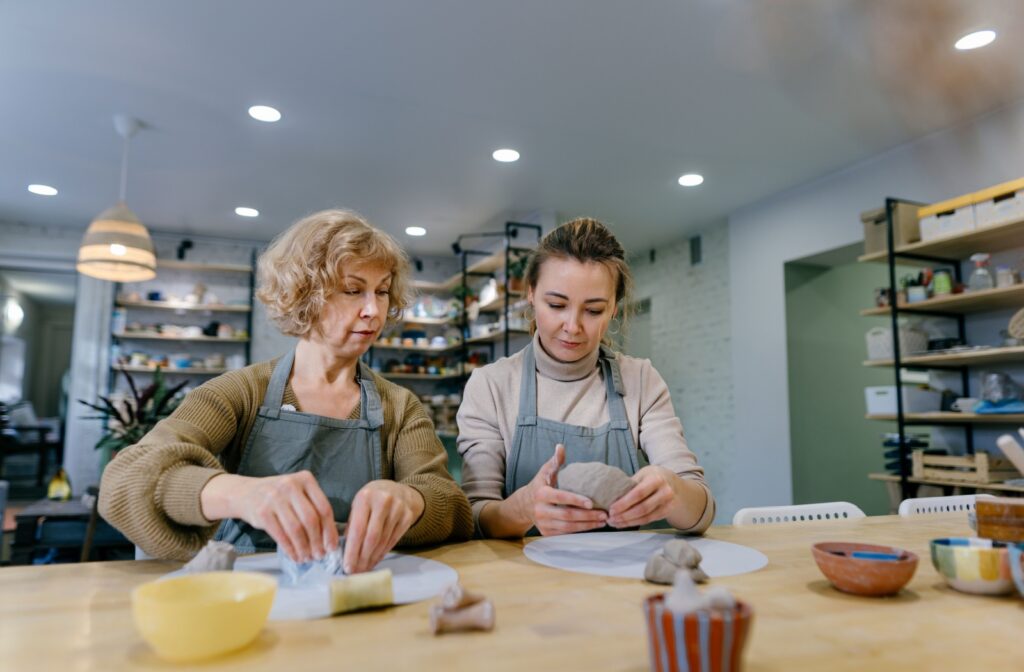Aging comes with its own set of challenges, but what if staying active and connected could help older adults lead more fulfilling lives? That’s the essence of the Activity Theory of Aging, which proposes that older adults who continue to foster social connections and who stay physically active as they age have better overall well-being and a higher level of happiness with their lives.
As our senior population continues to grow, recognizing and implementing this theory is crucial to maximizing older adults’ well-being—which is something that assisted living communities excel at doing.
Understanding the Activity Theory of Aging
The Activity Theory of Aging, first introduced in the 1960s by social scientists Robert J. Havighurst and Ruth Albrecht, posits that maintaining social and mental engagement is crucial for the well-being of older adults.
Unlike earlier theories that associated aging with withdrawal and decline, this theory flips the narrative. It argues that seniors who maintain participation in meaningful activities and social roles experience greater happiness, a higher sense of purpose, and better overall health during their golden years.
The Activity Theory stems from the idea that “successful aging” is about replacing what is lost. For instance, when someone retires, they lose the structure of having a job, the social bonds they built with colleagues, and a sense of purpose tied to their career. According to this theory, replacing those roles with new activities, hobbies, or social commitments helps maintain emotional and physical well-being.
The theory emphasizes two main points:
- Social Engagement: Building and maintaining relationships helps seniors avoid loneliness and foster a sense of belonging.
- Active Living: Maintaining both mental and physical activity promotes better cognitive health, reduces the risk of chronic diseases, and enhances overall mobility.
Remaining active can help seniors feel empowered, happy, and connected as they age.
Incorporating the Activity Theory of Aging in Daily Life
The good news is that applying the principles of Activity Theory doesn’t require significant life changes. Here are practical ways seniors can stay active, stimulated, and socially connected:
1. Join Community Groups or Clubs
Whether it’s a gardening club, book club, or a night of bingo, participating in shared activities fosters meaningful connections. Many seniors find joy in bonding over shared interests, and these interactions can create a sense of community and belonging.
Pro Tip: Check out local meetup groups or libraries for senior-friendly classes and events.
2. Volunteer for a Cause You Care About
Nothing enhances a sense of purpose like helping others. Volunteering provides older adults with an opportunity to give back, whether by mentoring younger generations, assisting at a food bank, or participating in environmental initiatives.
Example: Programs like the AmeriCorps in the U.S. offer opportunities for seniors to get involved in their communities.
3. Explore Lifelong Learning Opportunities
It’s never too late to learn! Whether you’re mastering a new language, taking a painting workshop, or learning how to use the latest technology, continuous learning keeps your mind sharp and prevents cognitive decline.
Tip: Online platforms like Masterclass or local community colleges often offer courses tailored for seniors.
4. Stay Physically Active
Regular exercise boosts physical health and improves mood and energy levels. Gentle exercises, such as yoga, swimming, or walking, are excellent ways for seniors to stay mobile and active.
Bonus: Exercise classes tailored to older adults offer the added benefit of social interaction.
5. Foster Close Relationships
Strong, supportive relationships are critical for emotional well-being. Whether it’s regular calls with family, meeting friends for coffee, or spending time with grandkids, maintaining close connections helps seniors feel supported and valued.
Idea: Set aside one day a week for a family gathering or phone call.
Engaging the Activity Theory of Aging in Assisted Living
While integrating the Activity Theory of Aging can be done independently, assisted living communities provide a supportive framework that makes it easier. These communities often design their programs and environments to align with the principles of active and engaged living. Here’s how:
1. Ample Social Interaction
Assisted living communities offer a built-in social network. Residents can attend communal meals, participate in group activities, and form friendships with peers. This sense of community reduces feelings of isolation and encourages seniors to engage socially.
Many communities host events such as movie nights, game tournaments, or cultural celebrations to promote interaction.
2. Structured Activities
Assisted living communities offer a variety of mental stimulation activities, from arts and crafts to educational workshops. These group activities not only challenge residents to learn and grow, but also create opportunities for shared joy and bonding.
3. Fitness Programs
Most assisted living communities offer tailored exercise programs, including senior-friendly fitness classes, stretch routines, and yoga sessions. These communities are designed to help residents maintain mobility, flexibility, and overall health.
4. Support for Lifelong Learning

Many communities partner with community colleges or library systems to offer classes to their residents. Courses on diverse topics, such as technology, cooking, or finance, give residents the opportunity to continue learning and stay intellectually engaged.
5. Volunteer Opportunities
Some assisted living centers partner with local charities, allowing residents to participate in volunteer programs. Whether it’s preparing donations or mentoring students, these opportunities provide a sense of purpose.
Making Aging Active, Joyful & Purposeful
The Activity Theory of Aging reminds us that growing older doesn’t have to mean growing isolated or stagnant. Instead, it’s about finding new ways to adapt, engage, and thrive. From community involvement to fitness programs and lifelong learning, there are countless ways for seniors to remain active and connected.
Bentley Commons at Lynchburg encourages our residents to take advantage of these opportunities to enhance their quality of life, while we alleviate stressors, provide personalized care, and support them in maintaining their independence.
Contact us today to discover how our community can help your loved one stay active and engaged in a meaningful way.


